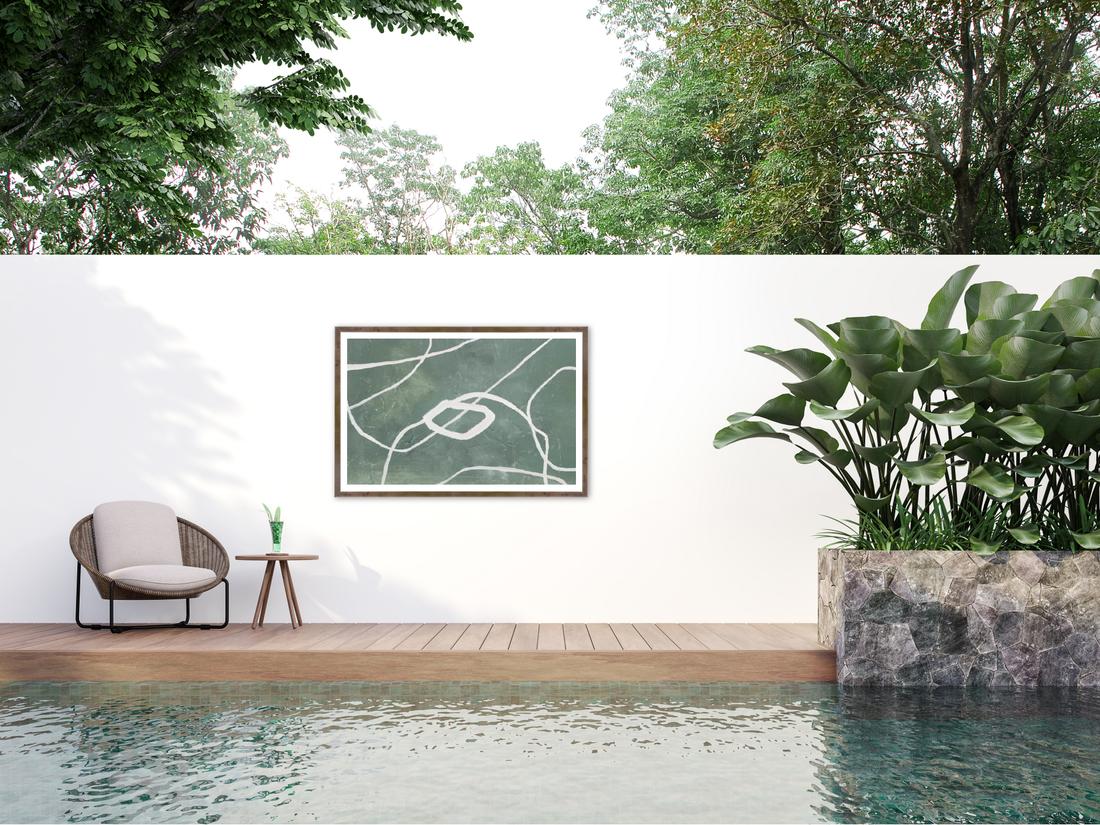Art has the power to transform outdoor spaces, adding personality, charm, and visual interest to gardens, patios, and poolside areas. However, displaying artwork outdoors comes with its own set of challenges, from sun exposure to moisture damage. In this guide, we'll explore how to frame art for outdoor and poolside areas to ensure your masterpieces remain protected and beautiful for years to come.
Understanding Environmental Risks
Before diving into framing techniques, it's crucial to understand the environmental risks that outdoor art faces
Sun Exposure
One of the most common threats to artwork, whether it's paintings, photographs, or prints, is sun exposure. Over time, prolonged exposure to sunlight can lead to fading and deterioration, diminishing the vibrancy and quality of your cherished pieces.
Moisture and Mildew
Damp and outdoor environments provide the ideal conditions for mold and mildew growth due to factors like exposure to rain, water from sprinklers or pool splashes and lack of ventilation. Certain materials are more prone to provide nutrients for mold and mildew spores to thrive and multiply. So how do we prevent this from happening?
How to Prevent Damage
To ensure the longevity and beauty of your outdoor art collection, it's essential to implement proper framing techniques, choose the right materials, hang artwork securely, and maintain it regularly. Let's take a closer look into each aspect of how to protect framed outdoor art to help you preserve your cherished pieces for years to come.
Choosing the right materials
Selecting the appropriate materials for outdoor artwork is crucial for ensuring durability and longevity. Consider the following factors when choosing materials:
- Artwork Substrate: Choose artwork that is suitable for outdoor display, such as prints on weatherproof paper or paintings on treated canvas. Avoid using delicate or water-sensitive materials that may deteriorate quickly in outdoor environments.
- Frame Material: Select frames made from weather-resistant materials that can withstand exposure to the elements without corroding or warping. Aluminum and stainless steel frames are ideal choices for outdoor use due to their durability and resistance to rust.
- Mounting Hardware: Use high-quality mounting hardware, such as stainless steel screws or hooks, to securely hang the artwork outdoors. Ensure that the hardware is designed for outdoor use and can withstand the weight of the artwork to prevent accidents or damage.
How to Waterproof Art for Outdoors
Framing artwork for outdoor display requires careful consideration of materials and techniques to provide optimal protection against environmental damage. Follow these guidelines for proper framing:
- Seal the Frame: Ensure the frame is properly sealed to prevent moisture from penetrating and damaging the artwork. Use weatherproof sealants or silicone caulk to create a tight seal between the frame and backing board.
- UV-Protective Glazing: Opt for UV-resistant acrylic or museum-grade glass to protect the artwork from harmful UV rays. UV-protective glazing filters out most of the damaging UV radiation while maintaining clarity and visibility.
- Conservation Mounting: Use archival-quality mounting techniques, such as acid-free mats and backing boards, to create a protective barrier between the artwork and the frame. Conservation mounting helps prevent moisture buildup and deterioration of the artwork over time.
- Remember that even with your best efforts, there's always a risk of damage when displaying art outside, if a piece is precious to you, or an original keep it safe indoors.
How to Hang Outdoor Art
Properly hanging artwork outdoors is essential for ensuring stability and longevity. Select a stable and flat surface for hanging artwork, such as a sturdy wall or fence. Avoid hanging artwork in areas prone to strong winds or excessive moisture, as these conditions can increase the risk of damage. Install durable hanging hardware, such as stainless steel wire or D-rings, to securely attach the artwork to the mounting surface. Ensure that the hardware is rated for outdoor use and can support the weight of the artwork. Before hanging the artwork, use a level to ensure it is straight and properly aligned. Test the stability of the hanging hardware by gently tugging on the artwork to ensure it is securely attached to the mounting surface.
Maintenance and Care
Once you have your art safely sealed and hung up outdoors, it's still going to need regular maintenance to preserve the condition of outdoor artwork and preventing damage over time. Follow these maintenance tips to keep your framed artwork looking its best:
- Inspect Regularly: Conduct regular inspections of the artwork to check for signs of damage, such as fading, warping, or moisture buildup. Promptly address any issues to prevent further deterioration.
- Clean as Needed: clean the artwork periodically using gentle cleaning methods appropriate for the material. Use a soft brush or cloth to remove dust and debris, and avoid using harsh chemicals or abrasive cleaners that may damage the artwork.
- Monitor Environmental Conditions: keep an eye on environmental conditions, such as temperature, humidity, and sunlight exposure, to ensure they remain within safe limits for outdoor artwork. Consider using a hygrometer and thermometer to monitor conditions and make any necessary adjustments to protect the artwork. If a storm is coming, safely store the art indoors until it passes.
Sit Back, Relax and Enjoy!
When it comes to hanging art outdoors set yourself up for success by choosing outdoor-safe materials, following proper framing techniques, hanging artwork securely, and maintaining it regularly. With a little extra work you can protect your framed artwork from damage and ensure it remains beautiful and vibrant for years to come. Whether displayed in a garden, patio, or poolside area, outdoor artwork adds visual interest and personality to outdoor spaces, enhancing your enjoyment of the outdoors while preserving the beauty of your cherished pieces. With meticulous attention to detail and ongoing maintenance, you can safeguard your outdoor art collection, ensuring it remains a source of enjoyment amidst the beauty of nature for years to come.

